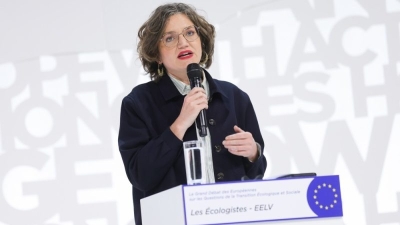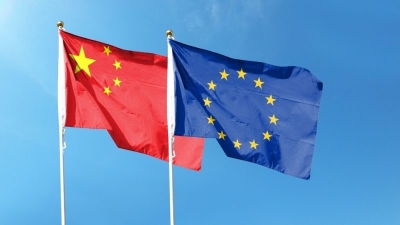Discussion: How to allocate and communicate recycled content in packaging?

To promote the uptake of recycled plastic in packaging material, the European Commission has set recycled content targets in the Single-Use Plastic Directive (SUPD) and its Packaging and Packaging Waste Regulation (PPWR). The lawmaker aims to develop a methodology of how to measure, allocate and communicate recycled content in packaging products. Once developed, it will set a precedent and have further implications for other types of materials and products – such as construction materials, batteries, vehicles and, most likely, textiles.
The CEOs of three family-owned large and medium-sized companies representing the recycling and consumer goods value chain discuss about the opportunities and risks a common allocation method would have for their industry and how it could affect the consumer’s role in a circular economy.
Reinhard SCHNEIDER is the owner and CEO of Werner & Mertz, the company behind the sustainable ‘Frosch’ (‘Frogg’) brand. Philipp LEHNER is CEO of ALPLA, one of the world’s biggest producers and recyclers of rigid plastic packaging, supplying customers with products made from up to 100% recycled PET and HDPE. Herwart WILMS is Managing Director of Remondis, one of the world’s biggest recycling firms and developer of innovative recycled materials.
Herwart WILMS:
When talking about „post-consumer recycled content”, it is a little-known fact that, already today, high volumes of high-quality PET and also HDPE recyclate for food and cosmetic-grade consumer packaging formats are being produced through mechanical recycling on a daily basis. Each ton of recyclate saves 1,6 tons of CO2 emissions.
Reinhard SCHNEIDER:
This is one of the reasons why we developed our first “Frosch” PET bottle made from 100% recycled consumer waste back in 2014 together with ALPLA. Closing the materials loop keeps valuable resources in use, which reduces the production of new plastic from virgin resources. From this experience, we know that the recycling targets in the PPWR are realistic and can be met with mechanical recycling technologies. High-quality recycling helps achieve the goals of the Paris Agreement, too.
Philipp LEHNER:
The role of the consumer should not be underestimated either. They are conscious about their buying power and their responsibility for the packaging they are taking home. To help them make sustainable purchasing choices, they should know about the environmental impact of the product they are buying. And that applies to packaging as well. Wherever they read „This bottle is made of 100% recycled plastic“, for example, they should be able to take the word for it.
Herwart WILMS:
Yes, consumers’ trust is key. That is why a robust and trustworthy method to substantiate claims about recycled content is so important. Materials running through a mechanical recycling process remain highly traceable, whereas multi-output technologies like chemical recycling rely on mass-balance allocation schemes to calculate the recycled content in a product.

Remondis
In my opinion, the issue is not in the concept of mass balance as such. It is the lack of traceability and transparency. Adding up recycled content „credits“ from different recycling, for example, could result in a bottle „Made of 100% recycled plastic“ that in reality contains less or no recycled plastic at all. That would be irritating and against the interests of the consumer.
Reinhard SCHNEIDER:
This is why we need a fair chain of custody method for mass balance, where recycled content must be allocated proportionally to all products of a recycling process at a batch level and not at facility or company level, so that claims regarding recycled content reflect the actual proportion present in a material. If a “recycled content“ claim is based on a mere accounting exercise rather than facts, the consumer would feel cheated.
A label reading “100% recycled content” should only be allowed for packaging products fully made from recycled content. Otherwise, it should be considered a misleading environmental claim. We as brand-owners expect a level playing field.
Philipp LEHNER:
We as recycler and producer need investment incentives for developing recyclable packaging to achieve a true circular economy and expanding recycling infrastructure. Targets for recycled content and recyclability only make sense and can promote the upscaling of recycling if they are achievable and traceable. Otherwise, it would be a terrible blow to the efforts and credibility of brands, recyclers and policy makers. Therefore, declarations about recycled content must be based on the actual amount included in a packaging item.
Herwart WILMS:
There is also a market issue with a free allocation method, as it would boost the demand for cheaper virgin plastics, which is needed to complement and thereby dilute recycled content from chemical recycling for new packaging. This would make mechanically recycled plastics even more expensive and might have disastrous consequences for our industry.
Small and medium-sized companies are affected most, as many of them have invested in mechanical recycling and rely on the high-quality plastic recyclate it produces. Eventually, it would put us off investing in the R&D of circular design and innovation like sustainable packaging products made of mono material with organic barrier coatings, for example. For us alone, planned annual investments of 1,1bn EUR per year are at stake.
Philipp LEHNER:
Yes, this goes for us as well. Already now, the price fluctuation for high-quality plastic recyclate is considerable. To stimulate further investment in mechanical recycling capacity and innovation, regulatory incentives are of the essence. To this end, packaging formats made of recycled content up to 100% should benefit from harmonised eco-modulation systems across the EU, as well as the level of their mechanical recyclability performance in the format of a grading system, as proposed in the PPWR.
Reinhard SCHNEIDER:
A proportional allocation of recycled content in a mass balance approach is technically feasible for all recycling technologies. It is ready to meet the recycled content objectives of the PPWR and without jeopardising consumers’ trust. For the European industry, mechanical recycling will create new business opportunities and employment, especially for family businesses and SMEs. It will strengthen the EU’s recycling capacities, decrease our dependency on fossil fuels and thus help them stay on track for climate neutrality by 2050.



